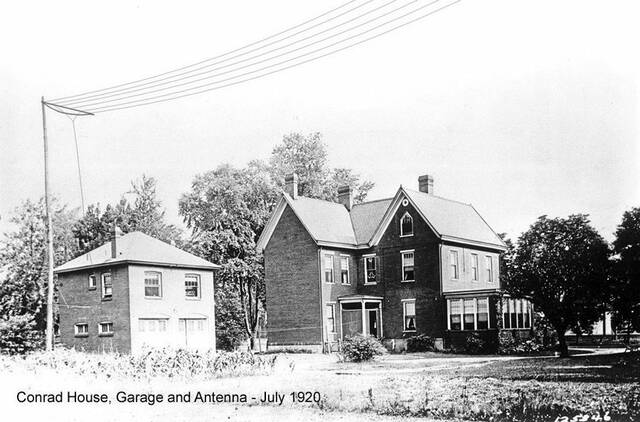National Museum of Broadcasting Pittsburgh announces plans for museum site, seeks funding
Nov. 2, 1920, is widely recognized as the day of the first commercial radio broadcast.
Westinghouse Electric and Manufacturing Company in Pittsburgh, under the call sign KDKA, broadcast Leo Rosenberg reading the live returns of the presidential election between Warren G. Harding and James Cox. This was the first time radio had been used for a commercial voice-and-music service.
By August 1921, KDKA broadcast its first professional baseball game, with Harold Arlin announcing a play-by-play of the Pirates’ victory over the Phillies. That October, the station broadcast the first live football game, a match between West Virginia University and the University of Pittsburgh.
In addition to honoring the historical broadcast by rededicating the state marker to a site near where it took place on the 103rd anniversary, the National Museum of Broadcasting Pittsburgh has officially announced plans for a museum that showcases the origin of broadcast and electronic media.
The idea has been in the works since 1986. After years of collecting, board members have decided their work can finally come to fruition with more funding.
“Through the museum and through the artifacts, we don’t want to just preserve, we want to tell the story,” said Rosemary Martinelli, a member of the National Museum of Broadcasting board. “It’s amazing when you look at the history of our region, and every single day people look at things and can say that those things help us tell the story of who we are and where we’re going.”
In partnership with the Regional Industrial Development Corporation, the museum board plans to use a vacant bank building across from Keystone Commons in East Pittsburgh to house the museum.
The organization said it needs funding to lease or buy the building.
“We’ve partnered with them on storing some of the historic materials,” said Tim White, senior vice president of RIDC. “We’ve been trying to help them preserve some of this history and find a spot for (the museum).”
White said that the museum’s board members have been working closely with RIDC to see how they can redevelop the building to fit the vision for the museum. The development company is no longer advertising the building for sale while the board attempts to get more funding.
The building where the first broadcast took place, which RIDC also owned, was unable to be used for the museum because it was torn down years ago, White said.
“Pittsburgh, I think more than any other city in the world, has a historical background in the development of radio, television and electronic media,” said Rick Harris, secretary and treasurer of the National Museum of Broadcasting. “Our museum is not just going to be about the history and things that happened here. It’s going to be about all of media history, not what just happened in Pittsburgh.”
Harris said that the museum’s organizers have been collecting paper materials, photos, radios, televisions, recordings and anything else they have been able to find and preserve related to broadcast history. Many artifacts have been found by board members or donated by community members who support the cause.
“We just need additional funds,” Harris said. “We have limited space to store these materials. It’s very expensive to keep these materials in storage.”
The largest artifact that the museum possesses is the deconstructed Frank Conrad garage, where Conrad constructed his station, 8XK. It was the precursor to general public broadcasting and led to the founding of KDKA.
“It’s our prized possession of sorts,” Harris said.
The garage was saved in 1972 when Alice Sapienza Donnelly stood in front of the bulldozer meant to knock down Conrad’s house. Harris said they plan to restore the garage using its original materials and let visitors inside to look at artifacts saved from the site.
“She recognized the value in that building and the fact that it was where broadcasting was born,” said Bill Hillgrove, president of the National Broadcasting Museum board and Sapienza Donnelly’s son-in-law.
Hillgrove said he wants to continue the work that he and the original set of board members began.
“This is a hard-working board from all different backgrounds,” Hillgrove said. “We all contribute different skills. We’re that close, we just need a monetary push.”
Hillgrove said that the board is looking into grants, fundraising and possibly trying to recruit some benefactors to help get the money they need. Funding will be used for artifact storage, obtaining the building, renovations and incorporating educational programming into the museum once it’s up and running.
According to the Federal Communication Commission, within four years of the initial KDKA broadcast, 600 stations existed in the United States and radio provided syndicated news, sports and music to listeners across the country. For years, radio was the fastest reliable way to receive updates about national and world events.
Haley Daugherty is a TribLive reporter covering local politics, feature stories and Allegheny County news. A native of Pittsburgh, she lived in Alabama for six years. She joined the Trib in 2022 after graduating from Chatham University. She can be reached at hdaugherty@triblive.com.
Remove the ads from your TribLIVE reading experience but still support the journalists who create the content with TribLIVE Ad-Free.




